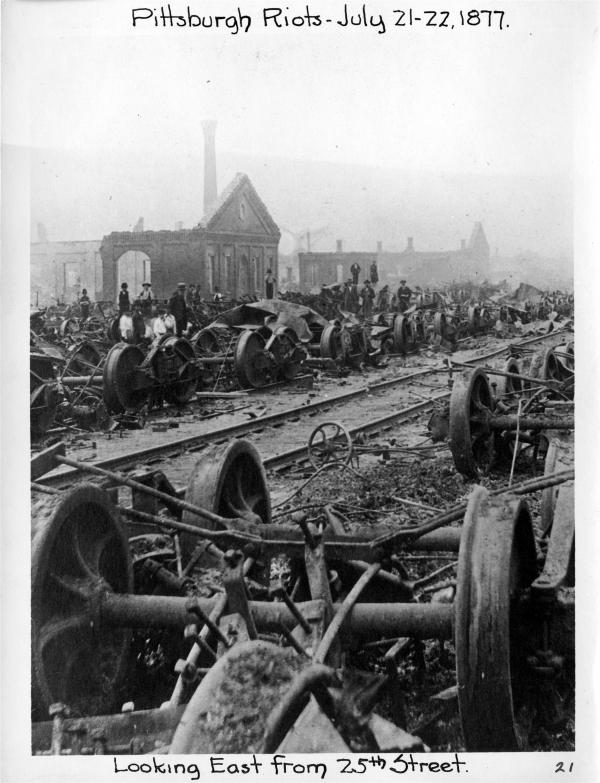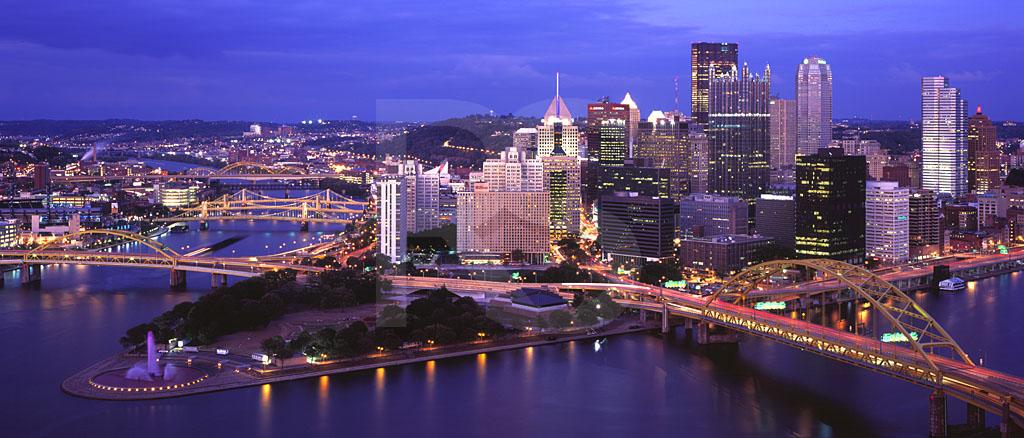
Map courtesy upload.wikimedia.org.
By 1875, the town started manufacturing what it became famous for: steel. Many Scottish and Irish immigrants filled its steel factory. Industrialists made their fortunes here including: Andrew Carnegie, Charles Swab, Hnery Frick and George Westinghouse. The 1800's also saw an influx of German immigrants including a mason named Heinz whose son would go on to make ketchup.

Abandonned German Evangelical Church courtesy blogspot.com.
By 1911, Pittsburgh's steel factories were producing half of the nation's steel. Besides steel, another industry in Pittsburgh was the railroad. The Great Railroad Strike of 1877 led to riots. Forty buildings were burned including the Pennsylvania Railroad & Depot . Even so, the railroad was able to recover. by 1911, Pittsburgh had 60K cars and a yearly traffic of 9 million tons. Pittsburgh also boasted 27 miles of harbourfront.

Railroad riot circa 1877 courtesy explorepahistory.com.
From 1870 to 1920, Pittsburgh's population increased by seven fold. South Side, Polish Hill, Blooomfield and Squirrel Hill were held many of the city's 21,000 Jewish residents. From 1916 to 1930, Blacks fromt he Deep South migrated north to settled in the Hill District. Wylie Avenue became the jazz district where such greats as Duke Ellington lived. Fifth Avenue, where the wealthy lived, became known as "Millionaire's Row".

Duke Ellington (at piano) courtesy wordpress.com.
The Second World War brought another opportunity for Pittsburgh industries to profit. They made 95 million tons of steel for the war effort. But with industry came pollution. Pittsburgh became so smog filled during the day that it earned the nickname the "Smoky City". An earnest attempt to clean up the city was undertaken in the 1930's and 1940's. While the air might have improved, however, slag continued to be dumped into the local rivers for another three decades.

Pittsburgh celebrating V-J Day circa 1945 courtesy tumblr.com.
Nineteen fifty saw Pittsburgh's population peak at 676,000 people. It seemed like the city would continue to grow. But Pittsburgh was in for some rough times. In the 1950's, the Lower Hill District was destroyed in the name of urban renewal. What was intended to be a huge shopping district only amounted to one new building, a civic centre.

The Smoky City courtesy blogspot.com.
In 1968, after Martin Luther King Junior's assassination, rioting erupted in the city. But by the 1970's, Pittsburgh's steel companies started to lose ground to foreign competition. The white flight syndrome of so many American cities took place here as well.

National Guard imposes curfew after Hill District race riots circa 1968 courtesy www.post-gazette.com.
Pittsburgh could boast a series of firsts: the first gas station, the first polio vaccine, the first Big Mac, the first heart transplant, the first robotics institute and the first U.S. public television station.

The first gas station courtesy explorepahistory.com.
But with the recession of the early 1980's, 153,000 layoffs hit the steel industry. Big names like Gulf Oil and Westinghouse left town, bought out by even bigger names.

Abandonned steel mill courtesy wordpress.com.
Today, poverty, crime and pollution continue to plague Pittsburgh. The population has dropped to 307,000 less than half what it was 60 years ago. And yet the city boasts three universities and several hospitals. Education and medicine have picked up where the railroad and steel have left off. Hopefully, Pittsburgh can reinvent itself.

Pittsburgh's skyline today courtesy ronsaari.com.
No comments:
Post a Comment